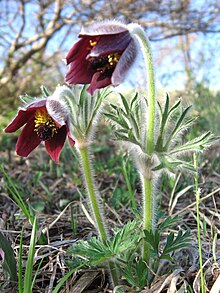| Crofoot&Eichelberger/sandbox | |
|---|---|

| |
| Scientific classification | |
| Kingdom: | Plantae |
| Clade: | Tracheophytes |
| Clade: | Angiosperms |
| Clade: | Eudicots |
| Order: | Ranunculales |
| Family: | Ranunculaceae |
| Genus: | Pulsatilla |
| Species: | P. cernua
|
| Binomial name | |
| Pulsatilla cernua (Thunb.)Bercht.&C.Presl.
| |
| Synonyms | |
|
Anemone cernua. Thunb. | |
Description edit
The common name for Pulsatilla cernua is narrow-leaf pasque-flower.[1] Pulsatilla cernua is a perennial plant that can grow to be about 0.2 m or 0.8 in tall.[1] This plant has six dark red/purple flowers and has tiny white, silky villose hairs. Pulsatilla cernua flowers from April to May, and then the seeds ripen from May to June. The Pulsatilla cernua relies on insects in order to pollinate. This plant has both the male and female parts, which means it is a hermaphrodite. Most parts of this plant are not edible, except for the roots and leaves. Since the root is edible, it can be used for small medicinal purposes. The root can be used as an anti-inflammatory and a sedative[1].
History edit
The history of Pulsatilla cernua is still somewhat unknown because it was recently found in the year 2012. Pulsatilla cernua belongs in the genus Pulsatilla, which has around 33 species in its genus. Most of these species are found in Asia, Europe, or North America. The Pulsatilla cernua is located in Asia.[2]
Taxonomy edit
Pulsatilla cernua is part of the kingdom Plantae and the phylum Tracheophyta.[3] It belongs in the kingdom Plantae because it is multi-cellular, non-mobile, and autotrophic. It is in phylum Tracheophyta because it is a vascular plant that has vascular tissue, which is xylem and phloem. This plant belongs to class Magnoliopsida because it is a flowering plant. The order is Ranunculales; this order is also known as peripheral eudicots. A peripheral eudicot has the basic characteristics of triaperturate pollen and also lacks the ethereal oils found in most basal angiosperms. It is part of the family Ranunculaceae. This family is the biggest family in its order. It is also known as the buttercup family. This family is mainly herbs, a few aquatics, and some vines or shrubs.[4] The genus Pulsatilla has 33 herbaceous perennial species that grow in meadows and prairies. Pulsatilla is derived from “pasakh”, which is the Hebrew word for Passover.[5]
Habitat edit
The Pulsatilla cernua is native to northeast Russia, Korea, and Japan. The range of this plant can be found in Eastern Asia: China, Japan, and Korea. This plant is commonly found in the low mountains of Japan as well as grassy slopes in the northern parts of China.[6] Pulsatilla cernua prefers moist soil, which is why it is found in lower parts of the mountains or on slopes. The soil must also be sandy and loamy and be well drained, or else the Pulsatilla cernua will not live and grow. Pulsatilla cernua can also grow in acidic, basic, or neutral soil.[1] It can even manage to grow in very alkaline soils. This plant also cannot grow in shady areas, and it must be in a position where it is almost always in the sun's light.
References edit
- ^ a b c d "Pulsatilla cernua PFAF Database". pfaf.org. Retrieved 2019-12-02.
{{cite web}}: CS1 maint: url-status (link) - ^ "Pulsatilla cernua". iNaturalist. Retrieved 2019-12-02.
- ^ "Pulsatilla cernua PFAF Plant Database". pfaf.org. Retrieved 2019-12-02.
- ^ "Ranunculales | plant order". Encyclopedia Britannica. Retrieved 2019-12-02.
- ^ "Pulsatilla", Wikipedia, 2019-07-20, retrieved 2019-12-02
- ^ Takaishi, Asuka; Kozhevnikov, Andrey E.; Kozhevnikova, Zoya V.; Ikeda, Hajime; Fujii, Noriyuki; Soejima, Akiko (2019-06). "Phylogeography of Pulsatilla cernua (Ranunculaceae), a grassland species, in Japan". Ecology and Evolution. 9 (12): 7262–7272. doi:10.1002/ece3.5298. ISSN 2045-7758.
{{cite journal}}: Check date values in:|date=(help)
